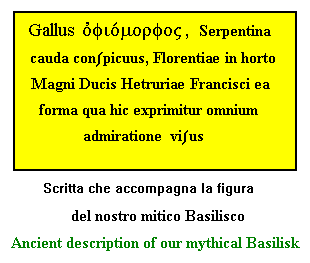|
L'immagine č tratta dalla pagina 97 del
Mundi Subterranei liber octavus, Sectio IV "
di Athanasius Kircher
pubblicato nel 1665
dove si tratta
"De animalibus
subterraneis" capitolo "De Genesi Draconum"
L'opera enciclopedica "Mundus
subterraneus in XII
libros digestus"
fa il punto sui fenomeni naturali, come erano noti e spiegati nel XVII°
secolo, un insieme di scienza, superstizioni e spiegazioni fantasiose.
L'immagine del Kircher riprende a sua volta una precedente
raffigurazione dovuta ad Ulisse Aldrovandi (
vedi ) che
recava la scritta
"Gallus cauda
quadrupedis cum crista gallinacea"
Gallus monstrificus
barbatus cornutus ocreatus cauda anguina in cuius extremitate est
flocus. Prope uropygium autem ubi adhaeret
corpori habet quoddam tuberosum rotundum colore albido.
Crista palearibusque plumosis.
Si noti la diversa estremitą della coda nel Basilisco di Kircher.
Il Baslisco di Aldrovandi compare la prima volta nel
1600 in forma semplice nell' Ornithologiae Liber XIV a pag 328 con la sola scritta: "Gallus cauda quadrupedis
cum crista gallinacea" (
vedi ). Ci furono nel XVII°secolo numerose altre versioni di questa
immagine. |
The image of the Basilisk is taken from page 97 of
Mundi Subterranei liber octavus, Sectio IV "
by Athanasius Kircher
published in the year 1665
the 8th volume deals
with the subterranean animals, and the origin of Dragons
It is part of the encyclopedic "Mundus subterraneus in XII
libros digestus"
a treatise in 12 volumes that makes the point on natural phenomena, as
they were known and explained in the 17th
century, a mixture of science, superstitions and fanciful explanations.
The figure of the Basilisk shown by Kircher was first depicted in early
17th century by Ulisse Aldrovandi
(
see here ).
The colour image was accompanied by the inscription
"Gallus
cauda quadrupedis cum crista gallinacea"
Gallus monstrificus
barbatus cornutus ocreatus cauda anguina in cuius extremitate est
flocus. Prope uropygium autem ubi adhaeret
corpori habet quoddam tuberosum rotundum colore albido.
Crista palearibusque plumosis. Note the
different tip of the tail in Kircher's Basilisk
The first image of Aldrovandi's Basilisk was published
in 1600 at page 328 of Ornithologiae Liber XIV as "Cock with quadruped
tail and cockscomb"
(
see here ). Several more
images of the Basilisk were published in
17th century
|
